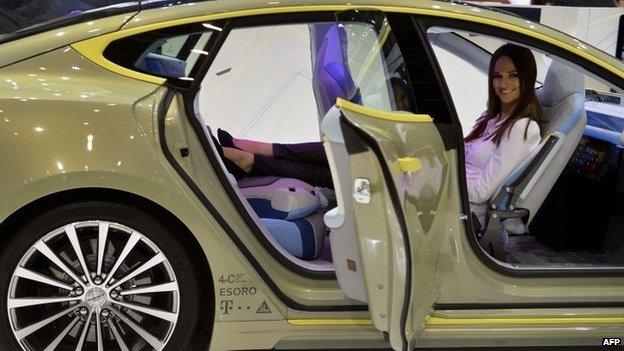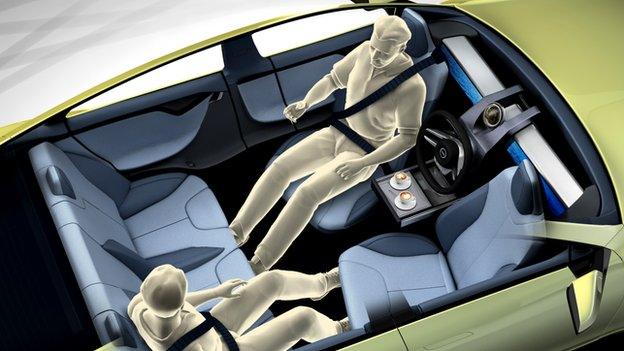Geneva Motor Show: Passengers' view of driverless cars
- Published

Autonomous cars, robotic cars, drone cars - call them what you will, but the self-driving car is coming to a showroom near you.
It might take a couple of years - it might take a couple of decades - but few people at the Geneva Motor Show would disagree that one day science fantasy will become fact.
However, while the likes of Google, BMW, Ford and IBM work on the technology, less attention has been given to what it means for passengers.
The Swiss automotive think tank Rinspeed has tried to give one possible vision of this future with its Xchange concept car, being premiered at Geneva.
"I wanted to put the passenger at the centre of what is possible, not the autonomous driving technology," says Rinspeed's founder and chief executive Frank Rinderknecht.
"Travelling in a driverless car will no longer require me to stare at the road, but will let me spend my time in a more meaningful way.
"The question then arises, would I like to work, to sleep, to read, to do whatever activities you might do on a train, a plane?
"I wanted to start thinking about how autonomous cars would 'move' people, and not just in the literal sense."
Swivel, tilt, slide
Rinspeed has taken a four-seater saloon and reconfigured the interior into something that would not look out of place inside a small private jet.
Except - and this was the real challenge - it is all done in a standard-sized car, in this case an electric Tesla Model S.
"It would have been easier in a van or stretch limousine, obviously," says Frank Rinderknecht.
The seats can swivel, tilt and slide into 20 positions, enabling passengers in the front to turn and face those in the back or lie back and watch a 32-inch screen.
The steering column can be moved into the centre for easier use of an information and entertainment system running the full length of the dashboard.
This features two pivoting LCD displays to surf the web, check emails, or video conferencing.

Someday, maybe all driving will be like this
Everything is fully connected to the world with real-time information and cloud services.
Mr Rinderknecht has even managed to fit in an espresso machine.
'Wickedly expensive'
Although the Xchange is experimental, Rinspeed worked with established sub-contractors to prove that the concept is feasible.
TRW Automotive made the moveable steering wheel; Harman made the entertainment system; Deutsche Telekom provided the connectively, and textile firm Straehle and Hess developed the luxury blue and grey interior colour scheme, designed to give the car a soothing maritime ambience.
And, because this is Switzerland, implanted in the centre of the steering column is a Carl F Bucherer wristwatch - a Patravi TravelTec - in a transparent globe.
The watch is wound as the car moves.
"Crazy, playful, but somehow also ingenious and wickedly expensive," says Mr Rinderknecht.
A Plexiglas roof from Evonik has 358 LED lights (there are 98 more in the instrument panel).
But it is not all about kicking off your shoes, dimming the lights and watching a movie.
Driverless cars will not mean the death of driving, Mr Rinderknecht says.
There will be times when a driver will want to drive.

The idea is to challenge traditional automotive design
'More agile'
"Most driving is boring because you are just eating miles and miles. If I go on the motorway from London to Birmingham, it's not very joyful.
"However, if I go over an Alpine pass I want to drive myself, I don't want the machine to do it."
Rinspeed is used to pushing automotive design to the limits. What Mr Rinderknecht calls his "crazy Swiss team" is behind several extreme projects, including its Squba underwater car.
"We are a small company and can think outside the box. We don't have all the big companies' constraints, processes, politics. We can be a lot more agile."
He chose the Tesla, partly because all-electric and hybrid vehicles are the future, but also because the configuration of the car was best suited for the multi-position seats.
"People won't want standard seats in autonomous cars. Have you ever tried to sit back in your car? Your shirt rides out of your trousers.
"We had to redesign the whole seating schematics."
Overcoming safety, liability, and regulatory issues will be big challenge for manufacturers of autonomous cars.
Rules governing seat safety are among the most complex - especially when designers want to have them flat - but few of us give it much thought.
Bumpy ride
"Our starting point was the business cabin of an aircraft and we went from there," Mr Rinderknecht says.
And then there is the issue of comfort.
"All that braking and going over bumps - you need a seat that will still let you relax," he says.
Rinspeed developed the seats with the world-renowned manufacturer of medical prosthetics, Otto Bock Mobility.
One of the remarkable features of the Xchange is the sense of space. Despite being crammed with features and technology it is, well, not that cramped inside.

Convincing people to use driverless cars may require a leap of faith
Mr Rinderknecht is already thinking beyond this concept car.
"There will come a time when we will be travelling in a container, with no airbags or seatbelts because the chances of an accident will be so small."
He sees a convergence of automotive technology and artificial intelligence as "an enabler of a new industrial revolution".
Increasing automation
But the real challenge may not be technological, or regulatory, but emotional.
Convincing people to travel in a driverless car will require a leap of faith.
"We know that nine out of 10 plane crashes are due to pilot error," he says.
"But, hypothetically, if you go to Heathrow Airport and have an option of flying in a plane with two pilots or a plane with no pilots, I know which one you will trust."
It may require a generation before people adapt but it will happen, he says.
"Everything in life is becoming automated. When I started to work I had a typewriter with a carbon ribbon band.
"When I look back at how things were, it looks like the Stone Age."